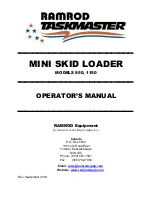
5
•
Use only Toro-approved attachments. Attachments can
change the stability and the operating characteristics of
the traction unit. Warranty may be voided if used with
unapproved attachments.
•
Keep all movements on slopes slow and gradual. Do
not make sudden changes in speed or direction.
•
Avoid starting or stopping on a slope. If the traction
unit loses traction, proceed slowly, straight down the
slope.
•
Avoid turning on slopes. If you must turn, turn slowly
and keep the heavy end of the traction unit uphill.
•
Do not operate near drop-offs, ditches, or
embankments. The traction unit could suddenly turn
over if a track goes over the edge of a cliff or ditch, or
if an edge caves in.
•
Do not operate on wet grass. Reduced traction could
cause sliding.
•
Do not park the traction unit on a hillside or slope
without lowering the attachment to the ground, setting
the parking brake, and chocking the tracks.
Maintenance and Storage
•
Disengage the auxiliary hydraulics, lower the
attachment, set the parking brake, stop the engine, and
remove the key. Wait for all movement to stop before
adjusting, cleaning, or repairing.
•
Clean debris from attachments, drives, mufflers, and
engine to help prevent fires. Clean up oil or fuel
spillage.
•
Let the engine cool before storing and do not store
near flame.
•
Do not store fuel near flames or drain indoors.
•
Park the machine on level ground. Never allow
untrained personnel to service the machine.
•
Use jack stands to support components when required.
•
Carefully release pressure from components with
stored energy.
•
Disconnect the battery or remove the spark plug wires
before making any repairs. Disconnect the negative
terminal first and the positive last. Reconnect positive
first and negative last.
•
Keep hands and feet away from moving parts. If
possible, do not make adjustments with the engine
running.
•
Charge batteries in an open well ventilated area, away
from spark and flames. Unplug the charger before
connecting or disconnecting it from the battery. Wear
protective clothing and use insulated tools.
•
Keep all parts in good working condition and all
hardware tightened. Replace all worn or damaged
decals.
•
If any maintenance or repair requires the loader arm to
be in the raised position, secure the arm in the raised
position with the hydraulic cylinder lock.
•
Secure the loader arm valve with the loader valve lock
anytime you need to stop the machine with the loader
arm raised.
•
Keep nuts and bolts tight. Keep equipment in good
condition.
•
Never tamper with safety devices.
•
Keep the traction unit free of grass, leaves, or other
debris build-up. Clean up oil or fuel spillage. Allow
the traction unit to cool before storing.
•
Use extra care when handling gasoline and other fuels.
They are flammable and vapors are explosive.
•
Use only an approved container.
•
Never remove the gas cap or add fuel when the
engine is running. Allow the engine to cool before
refueling. Do not smoke.
•
Never refuel the traction unit indoors.
•
Never store the traction unit or fuel container
inside where there is an open flame, such as near a
water heater or furnace.
•
Never fill a container while it is inside a vehicle,
trunk, pick-up bed, or any surface other than the
ground.
•
Keep container nozzle in contact with the tank
during filling.
•
Stop and inspect the equipment if you strike an object.
Make any necessary repairs before restarting.
•
Use only genuine Toro replacement parts to ensure that
original standards are maintained.
•
Battery acid is poisonous and can cause burns. Avoid
contact with skin, eyes, and clothing. Protect your
face, eyes, and clothing when working with a battery.
•
Battery gases can explode. Keep cigarettes, sparks and
flames away from the battery.
•
Keep your body and hands away from pin hole leaks
or nozzles that eject high pressure hydraulic fluid. Use
cardboard or paper to find hydraulic leaks; never use
your hands. Hydraulic fluid escaping under pressure
can penetrate skin and cause injury requiring surgery
within a few hours by a qualified surgeon or gangrene
may result.


























